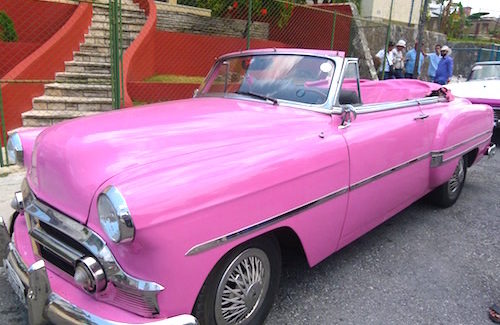Shore Excursion: 1950s American cars still cruising in Cuba
Eisenhower was president. The New York Yankees won their fifth world series in a row. Frank Sinatra was drawing movie goers with his film “From Here to Eternity.”
A 26-year-old Fidel Castro launched his failed attempt to overthrow Cuban dictator Batista on July 26. The first Corvette went on sale.
And the pink Chevy that I’m settling into for a ride through Havana first took to the streets.
The year was 1953. Almost seven decades later that 1953 Chevrolet is still transporting people around Cuba.
“It runs good but it’s hard to find parts when we have to fix it,” said driver Alex who has had the car for three years. His father owned it for two years before.
Although it has now become a popular tourist photo opportunity, driving classic American cars in Cuba is a necessity in a country that seems stuck in a time warp. Everywhere you look is a veritable moving car museum of old-school American brand vehicles used as Cuban taxis and everyday transport.
Though Cuba is less than 90 miles from Key West, Florida, the country has dealt with a feud that late leader Fidel Castro waged against America and vice versa.
In the 1950s under American-backed dictator Batista, Cuba was a playground for the rich and famous – including the mafia. Lots of American muscle cars, mostly General Motors models, were imported but Castro quickly put a stop to the casinos and the American imports.
“Before the revolution, the mafia owned these casinos,” Alex said, gesturing to large buildings that now serve other purposes. “After the revolution, there were no casinos.”
For more than half a century, American economic sanctions made new vehicles virtually unobtainable in Cuba. That meant no American vehicles and no American car parts.
The result, said tour guide Ricardo, is Cuban mechanics who are magicians. “We have ingenious mechanics who keep our cars running,” he said.
From the looks of some of them, many of these classic car bodies are held together with duct tape, wire and many layers of paint. The Chevy in which I’m touring Havana is missing a radio, odometer and cigarette lighter. In their places are empty spaces. A dashboard clock is permanently stuck at 9:40 o’clock.
“The car used to be blue,” Alex said. “I painted it pink.”
An estimated 60,000 pre-1959 American cars are still cruising Cuban streets. About 150,000 existed at the time of the 1959 revolution when all American manufacturers were forced to stop selling their wares in Cuba.
Every so often on my visit we would spot one of the oldies by the side of the road with its hood up. No AAA to call when a car breaks down in Cuba. Many are fixed with improvised parts right where they broke down.
Watching the old Dodges, Chryslers, Fords and Chevrolets roar down the road, I did notice an unusual motor sound. The reason, Alex said, is because many original motors were swapped for diesel engines. Diesel fuel is much cheaper than gasoline in Cuba.
Many men with cars are taxi drivers. They pay a fee to the government for a taxi license and pay part of the wages they earn to the government. Men lucky enough to own more than one car will often rent it to a driver or, if they are tired of driving, they will let another man drive their car and share the profits. So far, I haven’t seen any women taxi drivers.
Most Cubans work for the government at monthly salaries of about $20. Taking a taxi ride in one of the Cuban classic cars costs about $30 to $50 an hour for tourists and most Americans are happy to pay that, plus add a generous tip.
It would be sad to see the makeshift oldies disappear. They look like rolling works of art, a distinct part of Cuba.















View Recent Comments